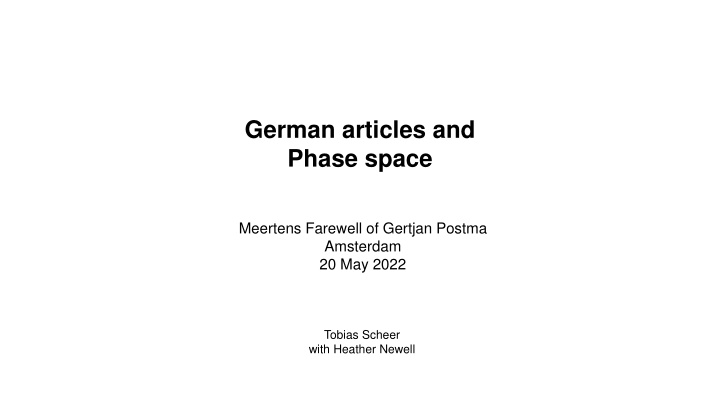
German Articles and Phase Space in Phonology Studies
Explore the intricate relationship between German articles, phase space, and phonological structures in linguistic studies. Learn about the distinct features of function words, diacritics, and pronunciation patterns within the context of syntactic and prosodic frameworks. Delve into the phonological aspects of prep + art contractions in Standard German, including definite article singular and plural forms.
Download Presentation

Please find below an Image/Link to download the presentation.
The content on the website is provided AS IS for your information and personal use only. It may not be sold, licensed, or shared on other websites without obtaining consent from the author. If you encounter any issues during the download, it is possible that the publisher has removed the file from their server.
You are allowed to download the files provided on this website for personal or commercial use, subject to the condition that they are used lawfully. All files are the property of their respective owners.
The content on the website is provided AS IS for your information and personal use only. It may not be sold, licensed, or shared on other websites without obtaining consent from the author.
E N D
Presentation Transcript
German articles and Phase space Meertens Farewell of Gertjan Postma Amsterdam 20 May 2022 Tobias Scheer with Heather Newell
this talk the phonology of function words is different - what's the difference? they are marked by a diacritic: "I'm a function word" computation then makes reference to this diacritic: "Constraints relating syntactic and prosodic categories apply to lexical syntactic elements and their projections, but not to functional elements and their projections" Truckenbrodt (1999: 224) Selkirk (1996, 2011); Truckenbrodt (2007); Ito & Mester (2018) NO Tyler (2019) better, but NO they come with a subcategorization frame they are syllabically underspecified: some segments are floating. In English, lexical forms of YES him ham C V C V C V | | | | 2 h m h m
this talk thus the regular pronunciation of Fnc words is without the floating segments: him is m, as in give'm the cup so where does the missing syllabic space come from when Fnc words are pronounced in full length? give him the cup from phase space. Scheer (2012: 307), D'Alessandro & Scheer (2013, 2015) Phase-initial CV Phasehood is phonologically marked by an initial CV at the left edge of the spell-out domain. 3
1. Data 1.1. General
German: def. art. data prep.+art. contractions are frequently found cross-linguistically: other West-Germanic languages: French Italian overview in Wescoat (2007) Heinrichs (1954) Cabredo Hofherr (2012) Augustin (2018) Standard German Phonological aspects of prep.+art. contraction (Verschmelzungsformen) are discussed by, among others: corpus: Hartmann (1978, 1980), Schaub (1979), Hinrichs (1984), Prinz (1991), N bling (1992, 2005), Schiering (2002, 2005), Augustin (2018) elicitation: Hinrichs (1984) and Raffelsiefen (1987) questionnaire: Dedenbach (1987) 6
German: def. art. data definite article singular Neut plural m, n, f masc der den Fem NOM ACC DAT GEN das die dem des den der der Hinrichs, Erhard W. 1984. Attachment of Articles and Prepositions in German: Simple Cliticization or Inflected Prepositions. Working Papers in Linguistics, Ohio State University 29: 127-138. has short forms after prepositions: auf den Beton > auf n Beton. elsewhere hat+das > hat's er hat's Auto gekauft we only look at prep+art here, but ultimately also ambition to account for other cases 7
German: def. art. data general restrictions coordination: both items must be either short or long, no mix Hinrichs, Erhard W. 1984. Attachment of Articles and Prepositions in German: Simple Cliticization or Inflected Prepositions. Working Papers in Linguistics, Ohio State University 29: 127-138. vor dem und nach dem Essen vorm und nachm Essen *vorm und nach dem Essen *vor dem und nachm Essen both long both short *short - long *long - sort contraction may only occur if the article introduces the complement of the PP It is impossible in case the article is deeper embedded. van Riemsdijk, Henk 1998. Head-movement and adjacency. Natural Language and Linguistic Theory 16: 633-678. von [dem K nig treu ergebenen] Dienern "of the servants who are faithfully loyal to the king" *vom 8
German: def. art. data long and short forms are both ok, in free variation. short forms have an effect on register (they are substandard), but there is no difference in meaning. except for a number of them zum, zur, beim, am, ans, im, ins, vom it is unclear why these and not others zum is official they have a regular (i.e. non-stigmatized) spelling auf'm is not official 9
German: def. art. data Kohler (1977: 219f), Hinrichs (1984: 129f), Hartmann (1978, 1980), Raffelsiefen (1987: 125-129), Schiering (2005: 52f), Cabredo Hofherr (2011, 2012), Augustin (2018: 193ff) properties of items whose long and short form are not in free variation generic reading of short forms to the school go "having secondary education" zur Schule gehen zu der Schule gehen "get close to the school" to the dentist go "see the dentist (class of dentists)" "see this particular dentist" zum Zahnarzt gehen zu dem Zahnarzt gehen idiomatic experssions: no long forms ins Gr ne fahren in the green drive "take a trip to the countryside" *in das Gr ne fahren uninterpretable 10
German: def. art. data properties of items whose long and short form are not in free variation am schnellsten "the fastest" superlative: no long forms *an dem schnellsten dem may cause the loss of the final C of the prep an dem > am *anm von dem > vom in dem > im anm exists, but represents the indef. art.: an einem Tag > anm Tag def. reading impossible (an dem Tag) *vonm *inm mit dem mit dem Auto mitm Auto mim Auto all ok Rhur (Schiering 2005: 56) auf dem nach dem nach m auf m nam aum 11
German: def. art. data Cabredo Hofherr, Patricia 2011. Verschmelzungsformen von Pr position und Artikel. Deutsch und Franz sisch kontrastiv. Deutsch im Sprachvergleich. Grammatische Kontraste und Konvergenzen, edited by Lutz Gunkel & Gisela Zifonun, 217-238. Berlin: de Gruyter. Cabredo Hofherr, Patricia 2012. Preposition- determiner amalgams in German and French at the syntax-morphology interface. Comparative Germanic syntax: the state of the art, edited by Peter Ackema, Rhona Alcorn., Caroline Heycock, Dany Jaspers, Jeroen van Cranenbroek & Guido Vanden Wyngaert, 99-131. Amsterdam: Benjamins. in all of these cases short and long forms that are not in free variation prep loses last C the literature goes for suppletion /mim/ > mim /mit dem/ > mit'm /zum/ > zum /zu dem/ > zu dem we side-step all these extras we only analyze those cases where long and short forms are in free variation and where the prep does not lose any consonant. 12
German: def. art. data ACC sg bis, durch, f r, um, gegen, ohne, an, auf, in, ber, unter, vor, hinter prep art noun masc auf den Beton neut auf das Haus fem auf die Mauer contraction auf n auf s * kommt es an kommt es an kommt es an DAT sg ab, au er, aus, bei, gegen ber, mit, nach, seit, von, zu, an, auf, in, ber, unter, vor, hinter, zwischen, neben prep art noun masc auf dem Beton neut auf dem Haus fem auf der Mauer contraction auf m auf m ? auf [ ] sitzt das Dach sitzt das Dach sitzt das Dach NB: this is a rhotic variety of German where coda r is [ ]. Hence /auf r/ = auf [ ]. 14
German: def. art. data GEN sg wegen , w hrend , infolge , statt , trotz prep masc wegen neut wegen fem wegen art des des der noun Betons Hauses Mauer Contraction ? wegen s ? wegen s ? wegen [ ] h lt das Dach h lt das Dach h lt das Dach plural no gender distinction prep ACC auf DAT auf GEN wegen art die den der noun Mauern Mauern Mauern Contraction * auf n ? wegen [ ] kommt es an sitzt das Dach h lt das Dach 15
German: def. art. analysis short forms of der, des reluctance is documented in the literature elicitation corpus studies Raffelsiefen (1987: 124) asterisks contractons with der, des (*aus'r) Augustin (2018: 109-123) reports (spoken) corpus data from the 0,9 million words FOLK corpus (Forschungs- und Lehrkorpus Gesprochenes Deutsch) of spoken German. des: complete absence of contractions der: contractions are rare but not inexistent. 16
German: def. art. analysis summary items that have short forms dem, den, das item without short form die short forms unclear: speakers are reluctant, uneasy, say they are strange, some reject der, des 17
2. Analysis 2.1. Phase structure
German: def. art. analysis N bling (1992), Augustin (2018), etc. the def. article optionally cliticizes on the preposition. what cliticizes on what is determined by the syntax. cliticization = loss of phasal autonomy the clitic is not spelt out in its own phase (cycle). variation between long and short forms is thus between the clitic being spelt out in its own phase or not. 19
German: def. art. analysis phase structure phase structure spell-out clitic [[host] [clitic]] host CV clitic full [[host] clitic] host clitic reduced the definite article is spelt out in its own phase and therefore a phase-initial CV is inserted at its left edge. the definite article does not undergo spell-out by itself, thus no extra CV occurs. the phase-status of PPs is subject to debate in the literature, but allomorphy may cross the PP-DP boundary (see Svenonius 2016, Newell & Noonan 2018 for recent discussion). The optionality at hand is therefore not entirely surprising from a syntactic point of view. 20
2.2. Decomposition and lexical identities
German: def. art. analysis Raffelsiefen, Renate 1987. Verschmelzungsformen in German: A lexical analysis. Linguistic Analysis 17: 123- 146. decomposition of the def. art. root case marker -r -n -m -s -s de de de de da die nom. masc., dat. fem., gen. fem. / pl. acc. masc., dat. pl. dat. masc. / neut. gen. masc. / neut. nom. / acc. neut. nom. / acc. fem. / pl. die only item that i) has no short form and ii) doesn't decompose. it has no short form because it doesn't decompose (see below). 22
German: def. art. analysis regular analysis of stable / unstable segments (French liaison etc.) unstable items are floating pieces of melody (roots) stable items are lexically associated to syllable structure (case markers) den, dem, das root lacks syllable structure in the lexicon case marker is fully syllabified in the lexicon die fully syllabified in the lexicon case marker zero, both segmentally and syllabically root + case ACC fem sg ACC m, n, f, pl C | n m s V d e ACC m sg, DAT pl DAT m, n sg ACC n sg root + case C V | | d i d a 23
German: def. art. analysis die ACC fem sg ACC m, n, f, pl when the root comes with its own syllable structure, it does not need any extra syllabic space and therefore will be pronounced no matter what, whether cliticized or spelt out by itself. root + case C V | | d i complementary distribution: items that have short forms have also overt case markers items that have no short forms have no overt case markers maybe a functional effect: the short form of die would be zero: the root segments would be floating, hence remain unexpressed, followed by a zero case marker. that would leave the entire def. art. without phonetic existence: *auf Mauer kommt es an the complete surface absence of the definite article is not viable because determiner information could not be recovered Christiansen (2012), Augustin (2018: 113f) 24
German: def. art. analysis variation #1: dialectal contracted die / der (but never des) is reported die inne (in die), anne (an die), aufe (auf die), umme (um die) inne (in die), umme (um die) inne Kesch gehe, umme Kesch erum gehe der vonne (von der), ausse (aus der), beie (bei der), nache (nach der) ane (an der), ine (in der) Ruhr, Schiering (2005: 56) Berlin, Hartmann (1980: 167) Hessian (Tobias) Ruhr, Schiering (2005: 56) Berlin, Hartmann (1980: 167) but then what is left of die /der is only ever a schwa. lexical form of die: d- Raffelsiefen (1987: 144) for Hessian that's a fact: uncontracted die is [d ] de Schull is us not for der, though: in [d ] Schull (vocalized r produces [ ]) 25
German: def. art. analysis variation #2 recall that de-r, de-s have contracted forms for some speakers in our analysis, this is a lexical difference: root segments de- lexically associated = no contraction root segments de- lexically floating = contraction 26
German: def. art. analysis Scheer (2012: 307), D'Alessandro & Scheer (2013, 2015) Phase-initial CV Phasehood is phonologically marked by an initial CV at the left edge of the spell-out domain. [A [B C]] is spelt out as CV+A + CV+ B + C Phase-initial CV = every [ gets an extra CV unit 28
German: def. art. analysis cliticized = spelt out in the same phase non-cliticized = spelt out in a distinct phase prep phase root case prep V | au f root case C V | C C V | C V C V | | au f C V C V | d e n n d e n d e n there is no syllabic space that the root segments could associate to. they remain floating and hence are not pronounced. the phase-initial CV offers the syllabic space necessary for the root segments to be pronounced: they associate. prediction: any time a long form of the def. art. is encountered, it was spelt out by itself, i.e. is a non-clitic. 29
German: def. art. analysis argument in favour of empty CV units (rather than other carriers of syllabic space) syllabic space inserted by grammar (stress) may come as x-slots moras CV units Chierchia (1986) Zimmermann etc. Strict CV typically it the difference plays no role but here it does what needs to be accommadated is exactly a consonant plus a vowel: de-, da- precisely what the CV unit provides x-slots and moras won't do. 30
German: def. art. analysis Focus enforces the long form "he's talking about this house, not about the other" von dem Haus redet er, nicht von dem anderen *vom support for a phase-based analysis: of course will items under focus be spelt out by themselves. 31
German: def. art. analysis definite article decomposed, based on phonological evidence singular neut plural m,n,f masc fem NOM ACC DAT GEN da di+CV de 32
1. Data 1.1. General
German: indef. art. analysis decomposition of the indef. art. root ei ei ei ei ei ei indef. n n n n n n case marker nom. masc. / neut., acc. neut. acc. masc. dat. masc. / neut. nom., acc. fem. dat., gen. fem. gen. masc. / neut. en em e er es indefiniteness marker the middle piece -n- which is present in all full forms does not belong to the root since it appears in short forms where the root is absent: mit nem etc. thus def. is zero: root def. case def. de n indef. ei n en den einen 38
German: indef. art. analysis as before: unstable items are floating pieces of melody (roots) stable items are lexically associated to syllable structure (case markers) root indef. case schwa preceding consonantal case markers is predictable and therefore does not need to appear in lexical representations (Giegerich 1987, Augustin 2018: 117 note 138). C | V | e ei ei ei ei ei ei - - - - - - n n n n n n - - - - - n m r s 39
German: indef. art. analysis phase structure as before, the host (prep.) is always a phase. long form: both the [root] and the [indef. + case] are a phase. short form: only the [indef. + case] is a phase. super-short form: neither is a phase. phase structure spell-out surface result a. [[host] [root] [indef. + case]] host + CV + root + CV + n + case long form b. [[host] root [indef. case]] host + root + CV + n + case short form c. [[host] root indef. case] host + root + n + case super-short form 40






















